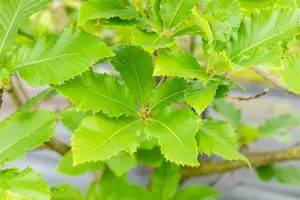Rosa Polareis - BUSH, bare root
Rosa Polareis - BUSH, bare root
Synonym
Synonyms (botanical): Rosa regeliana, Rosa rugosa 'Ritausma', Rosa rugosa 'Polar Ice'®.
Bulletpoints
* fruit ornamentation
* Suitable for flowering hedges
* the flowers are highly favoured by bees, bumblebees and hoverflies
* fragrant flowers
* tolerates pruning
* heat tolerant, drought resistant, resistant to urban climates, salt air tolerant, soil salt tolerant
Growth habit
Japanese rose 'Polareis'® is a bushy growing shrub that can reach a height of 60 - 80 cm and a width of 40 - 50 cm.
Water
Water regularly and allow the soil to dry out in the meantime.
Pruning
Pruning, ideally from March to April, is advisable for this plant.
Location
Preferred location in a sunny to semi-shady position.
Soil
No special requirements.
Planting time
Container plants can be planted all year round, except when the soil is frozen and in summer heat (over 30°C).
Tasks
- Fertilise: In the period from March to May
- Watering: In the period from May to September
- Pruning: In the period from March to April.
Flower
The light pink, cupped flowers are semi-double and appear from June to July. They grow to around 6 - 8 cm and are pleasantly fragrant.
fruit
The fruits of Rosa rugosa 'Polareis'® are particularly decorative. These appear from October.
Use
Group planting, bee pasture, hedge, bird food plant, jam, liqueur
Shoots
The shoots of Rosa rugosa 'Polareis'® are spiny.
Root
Rosa rugosa 'Polareis'® is a taproot plant and, depending on the soil, forms extensively branching, runner-forming roots.
- Article number215
-
EAN codeROPOLARE-2STVG
- Latin nameRosa Polareis
- catalogLandscape shop


